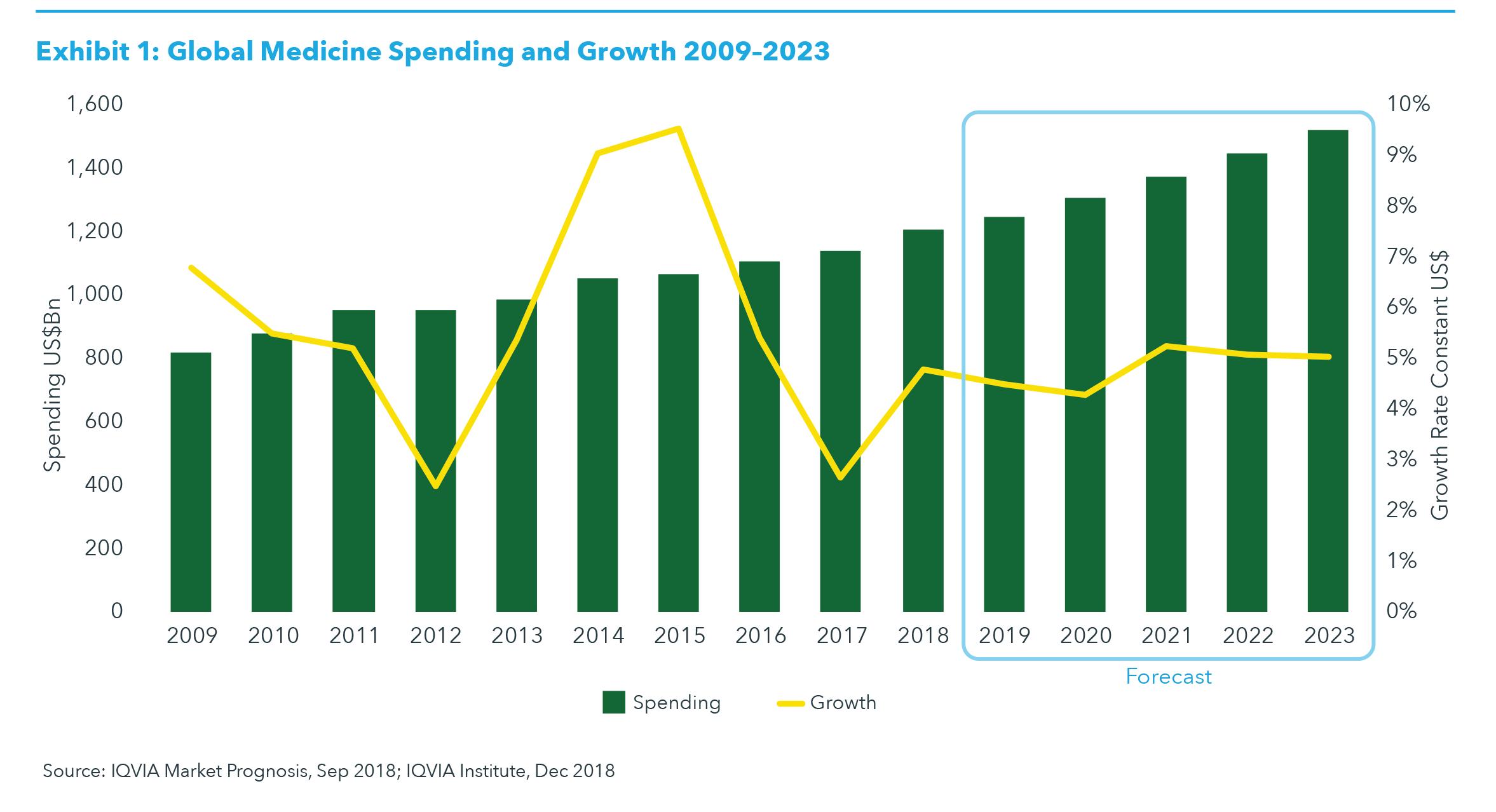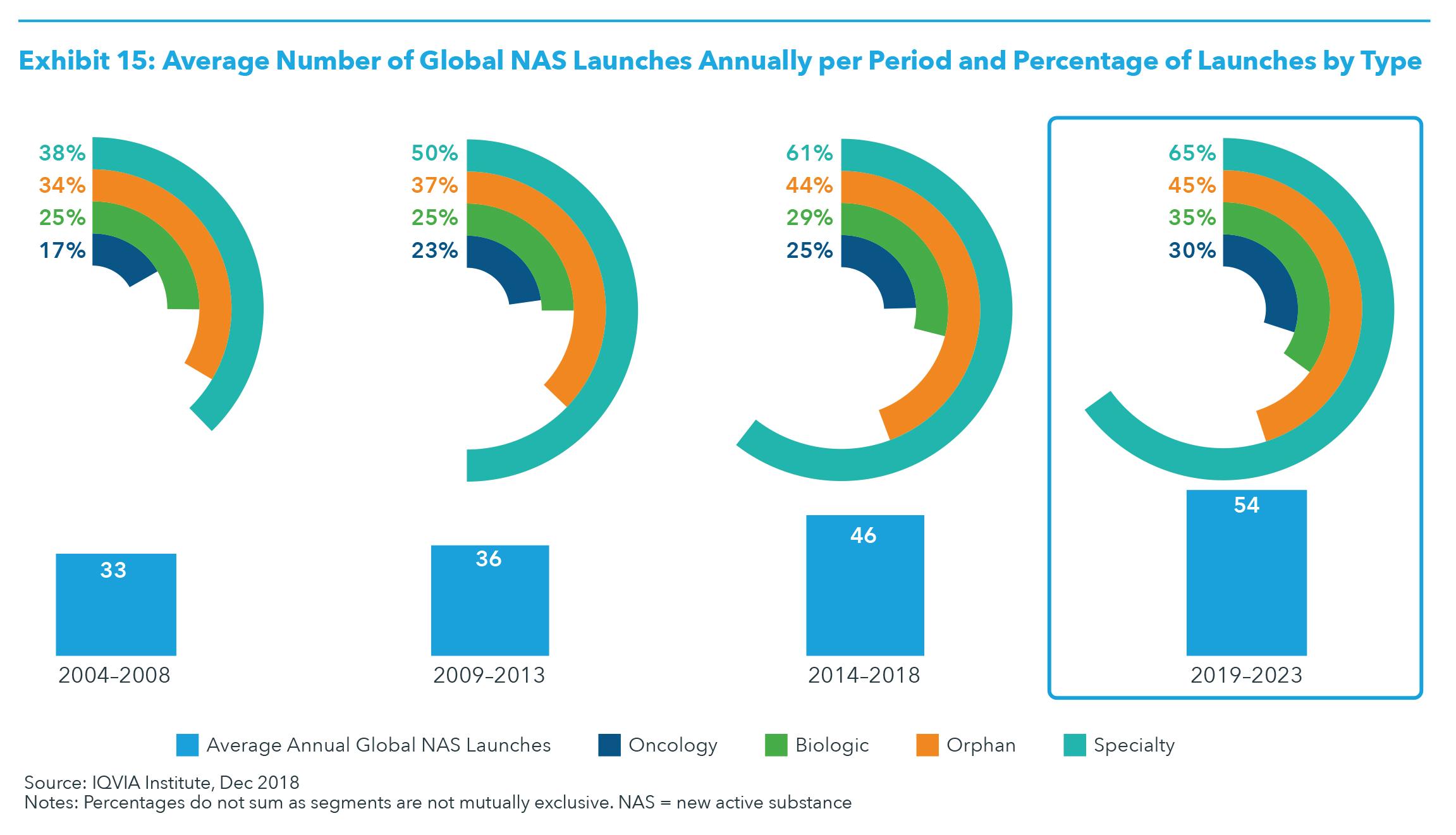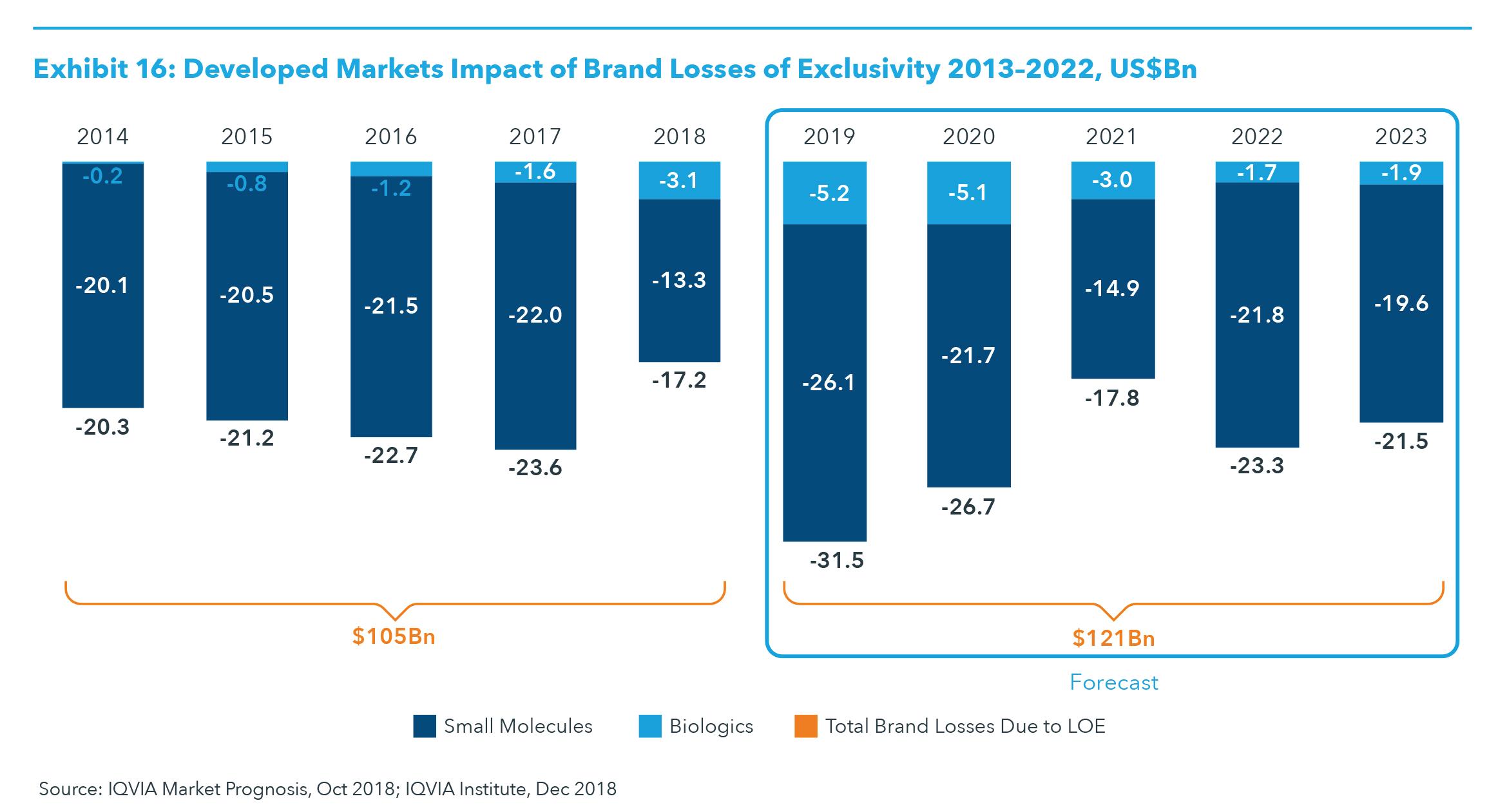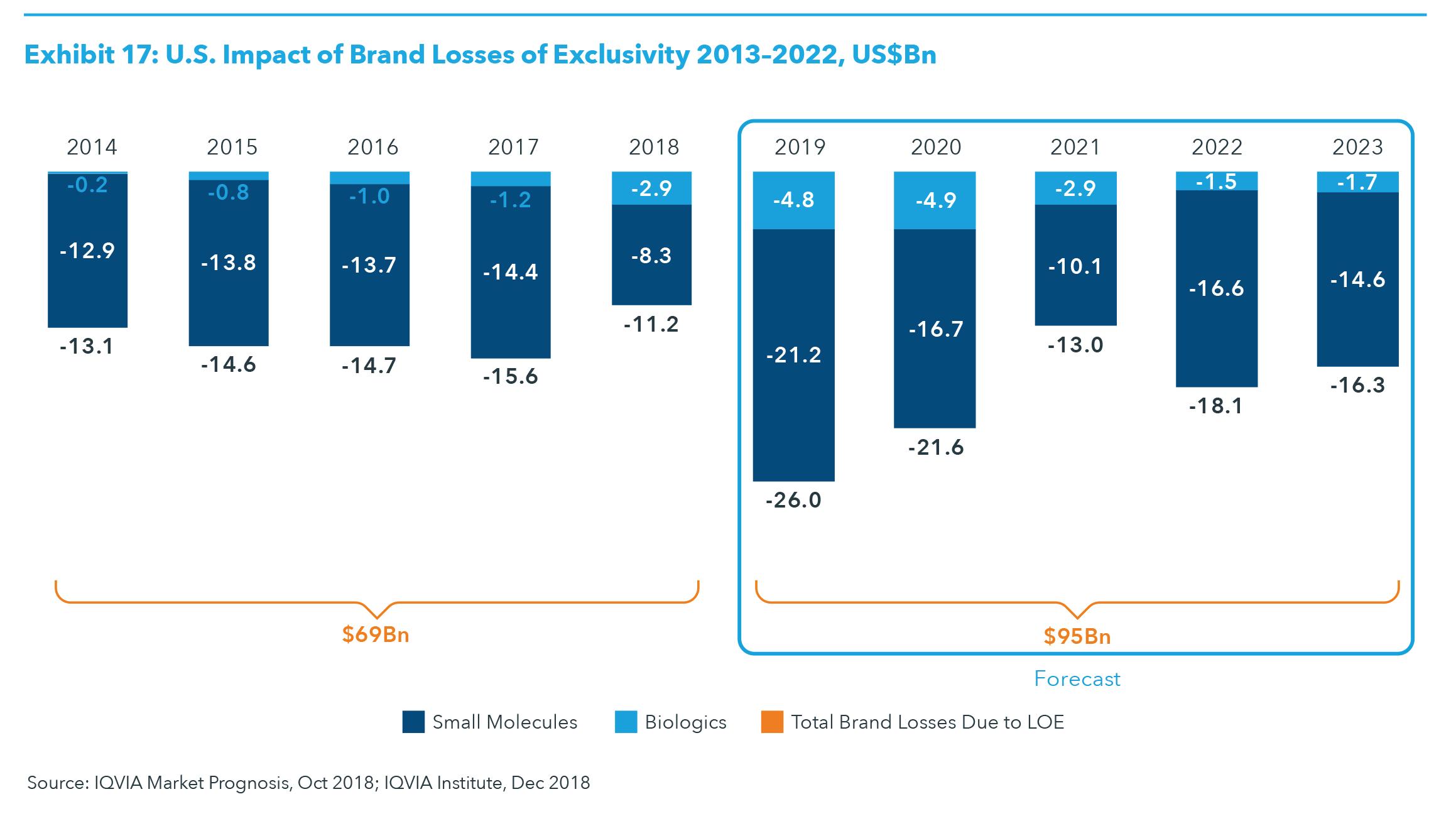
19 minute read
IQVIA’s 2023 Outlook for Global Medicines
The Global Use of Medicine in 2019 and Outlook to 2023
EXCERPTS FROM IQVIA’S REPORT ON THE INDUSTRY For the full report, see here
Advertisement
GLOBAL PREDICTIONS • Global spending on medicines reached $1.2 trillion in 2018 and is set to exceed $1.5 trillion by 2023 • Invoice spending in the United States is expected to grow at 4–7% to $625–655 billion across all channels, but net manufacturer revenue is expected to be 35% below invoice and have growth of 3-6% as price growth slows on both an invoice and net basis • Net drug prices in the United States increased at an estimated 1.5% in 2018 and are expected to rise at 0–3% over the next five years • China reached $137 billion in medicine spending in 2018, but will see growth slow to 3-6% in the next five years as central government reforms to expand insurance access to both rural and urban residents, as well as expansions and modernizations of the hospital system and primary care services, have been largely achieved and efforts shift to cost optimization and addressing corruption • Medicine spending in Japan totaled $86 billion in 2018, however, spending on medicines is expected to decline from -3 to 0% through 2023,
PERSPEC TIVE FORUM ON SOCIAL
MEDIA & TECHNOLOGY WEST COAST

S
PERSPEC TIVE FORUM ON SOCIAL MEDIA & TECHNOLOGY

S
FORUM ON SOCIAL MEDIA & TECH: WEST FORUM ON SOCIAL MEDIA & TECH: EAST OCTOBER 16, 2019 OCTOBER 23, 2019
Anaheim, CA | Anaheim Marriott Suites Jersey City, NJ | The Liberty House FEATURED SPEAKERS
P E T E R M U S C A R E L L A , S N A P , I N C . D E N I S E M E L O N E , H A V A S S F L Y N D I H I R S C H , D E R M I R A B R A D E I N A R S E N , K L I C K H E A L T H D A V I D G O L D S M I T H , W E G O H E A L T H
FST WEST AGENDA PREVIEW
Educating & Driving Action in Millennials through Unbranded Social Media
Lyndi Hirsch, Senior Director, Head of Consumer Marketing, Dermira Carla Harbrink, SVP, Management Director, FCB Health Deirdre Noonan, Director, Communications Design, Healix
Patient Influencer Perspectives on Pharma Digital Engagement
David Goldsmith, Chief Strategy Officer, WEGO Health Patient Thought Leaders TBD
Capitalizing on Awareness Month Activity in Social Media
Caine Fair, Director of Social Media, Havas SF
Denise Melone, Senior Director, Business Engagements, Havas SF
The Augmented Reality Future of Healthcare
Fred Church, Founder, Format Analytics
Real Life AI in Pharma Marketing
Abid Rahman, VP, Innovation, Intouch Solutions
For full agenda and more details, visit our conference websites. FST EAST AGENDA PREVIEW
The DTC Pharma Social Media Diet
Brandie Linfante, SVP, Engagement Strategy, Ogilvy Health
Martha Maranzani, SVP Content Strategy, Ogilvy Health Peter Muscarella, Senior Account Executive, Snapchat Social Media, Snap Inc.
Educating & Driving Action in Millennials through Unbranded Social Media
Lyndi Hirsch, Senior Director, Head of Consumer Marketing, Dermira Carla Harbrink, SVP, Management Director, FCB Health Deirdre Noonan, Director, Communications Design, Healix
Patient Influencer Perspectives on Pharma Digital Engagement
Laurel Netolicky, VP, Business Development, WEGO Health
Patient Thought Leaders TBD
Social Ad Creative: Findings from 11,000 Facebook Ads
Brad Einarsen, Senior Director, Social Media, Klick Health
The Augmented Reality Future of Healthcare
Fred Church, Founder, Format Analytics
WWW.DTCPERSPECTIVES.COM/FST-WEST WWW.DTCPERSPECTIVES.COM/FST ATTEND OUR 2019 FALL AWARDS
PERSPEC INNOVATOR TIVE AWARDS

S
DTC INNOVATOR AWARDS October 21, 2019 | Hanover Marriott | Whippany, NJ
PERSPEC TIVE AGENCY VANGUARD AWARDS

S
DTC AGENCY VANGUARD AWARDS October 23, 2019 | The Liberty House | Jersey City, NJ
Celebrate some of the best and most innovative people in the world of DTC marketing Honor some of the best creative minds working at advertising agencies in the DTC space
The DTC Innovator awards are designed to honor people who work This award is for elite marketers from advertising agencies. in the world of DTC marketing making products and properties This award helps recognize the faces behind successful DTC that help promote and improve DTC marketing effectiveness. A campaigns and patient programs. Agency executives will be nominee is someone whose innovative ways improve the DTC selected based on actual accomplishments, influence on future landscape by helping pharma promote their life-saving products DTC launches or campaigns, and/or recognized contributions and to consumers. service to patients as well as the DTC industry.
WWW.DTCPERSPECTIVES.COM/AWARDS
due to the effect of exchange rates and continued uptake of generics and offset by the uptake of new products • The number of new products launched is expected to increase from an average of 46 in the past five years to 54 through 2023, and the average spending in developed markets on new brands is expected to rise slightly to $45.8 billion in the next five years, but represent a smaller share of brand spending • The impact of losses of exclusivity globally is expected to be $121 billion between 2019 and 2023, with the United States accounting for just under 80% at $95 billion • By 2023, biosimilar competition in the biologics market will be nearly three times larger than it is today, but the key events are underway from earlier patent expiries, except the expected 2023 entrance of biosimilars to adalimumab (Humira) in the United States • Specialty share of total medicine spending will reach 50% by 2023 in most developed markets as the majority of new medicines have been and will continue to be in specialty classes
GLOBAL MARKET Global spending on medicines reached $1.2 trillion in 2018, up from $1.1 trillion in 2017, and is set to be just under $1.3 trillion by 2019, with 4–5% growth globally. Global spending is expected to exceed $1.5 trillion by 2023 as the market grows in mid-single digits (see Exhibit 1). Global growth of medicine spending through 2023 will primarily be driven by developed markets and their adoption of a wave of newly launched innovative products. Global growth will be driven to a lesser extent by expanded access and use of medicines in pharmerging markets, with China alone approaching the combined spending level of the five major European markets. Growth in the United States will be driven by new products and (at a lower level than prior years) by pricing shifts, and will be offset by losses of exclusivity, along with the emergence and growth of biosimilars.
U.S. MARKET Spending on medicines is expected to reach over $600 billion on an invoice basis in 2023, including spending in all channels (e.g., retail pharmacies, hospitals, doctors’ offices), and on all product types (e.g., small molecules, biologics, brands, generics, biosimilars). As invoice spending does not reflect off-invoice discounts and rebates, the trend looking at invoice prices can differ substantially from the trend after deducting those discounts and rebates. Net manufacturer revenue growth in the U.S. market is expected to be 2–3% in 2019, down from a high of 10.3% and 9.1% in 2014 and 2015, respectively. Overall invoice spending growth is expected to rebound in 2023 to 6.0% up from a low of 1.2% in 2017, although net manufacturer revenue growth is expected to be 1–2% lower than invoice growth at this time (see Exhibit 5). This increase in spending growth is expected to be driven by a substantial rise in the number of launches of new medicines, but will be offset by losses of market exclusivity of branded products. Real net per capita medicine spending is expected to grow at 0–3%, about a percentage point lower than the 2.8% growth seen over the prior five years when adjusted for population, economic growth and manufacturer concessions (see Exhibit 6).
U.S. PRICING TRENDS Drug pricing in the United States is a complex interaction between the prices set by manufacturers, negotiation with payers, competition between both branded and generic products and the design of public and private insurance programs that ultimately determine how much is paid by patients, payers and the government. These dynamics include both the prices set at launch and price changes that occur yearly (or more frequently) and the statutory and negotiated concessions manufacturers make afterwards. There has been significant attention given to the list prices of recently launched drugs, especially with the shift in innovation to specialty, orphan and oncology areas that often have higher prices. The median annual cost for new medicines in many of these therapy areas has risen to tens or hundreds of thousands of dollars in recent years and, in particular, oncology and orphan drugs can be expected to have median prices well above $100,000 per year by 2023 (see Exhibit 7). In the next five years, it is expected that launch prices could increase at a slower rate through a combination of factors including:
• Price competition with other innovative brands as seen already in hepatitis C and PCSK9 therapeutic classes • Independent review of pricing from bodies like the Institute for Clinical and Economic Review (ICER) or others with similar impact, and the effect of price transparency initiatives more generally • Recent level of breakthrough (e.g., CAR-T therapies, immune checkpoint inhibitors, etc.) will not be repeated as much as in past five years, i.e., breakthroughs will be more incremental

Price increases by manufacturers on established products have drawn public attention, as some have been deemed excessive by the public and policy makers. In the past two years, a range of companies made commitments to reduce list price increases for branded medicines, which are now below


6% per year on average, and are expected to remain in the 4–7% range within the next five years (see Exhibit 8). The net prices manufacturers receive for these drugs have grown more slowly as off-invoice discounts, rebates, statutory payments under the Affordable Care Act and the value of patient coupons have offset invoice price growth. Net prices increased at an estimated 1.5% in 2018 and are expected to rise at 0–3% over the next five years. Included in this overall average are the potential for some companies and products to have net price declines in the face of competitive markets. Additionally, net price growth was below inflation in the wider economy in 2018; an occurrence expected to continue for the next five years.
NEW PRODUCTS Globally over the past five years there has been a significant increase in the number of and spending on new active substances, particularly in the developed markets where they have historically launched first. Between 2014 and 2018, the average spending on new branded medicines was $43.4 billion. New products launching between 2019 and 2023 are expected to have a slightly higher overall level of spending, approximately $45.8 billion, but will likely represent only 6.7% brand spending, down from 8.2% between 2014 and 2018 (see Exhibit 14). There is a wide range of particularly important treatments expected to be launched in 2019 and 2020, with the biggest impact of those launches in the subsequent year. Along with the increasing number of launches, the type of products continues to shift to specialty, orphan, biologic and oncology products. Specialty is expected to represent nearly two-thirds of newly launched medicines over the next five years, and oncology approximately 30% (see Exhibit 15). Orphan drugs could represent 45% of new active substances should the level of FDA orphan designations for in-progress research and breakthrough designations produce successful launches at current, historic rates. With these shifts in the type of products launching, price per patient is likely to be increasingly high, while the number of patients treated by these therapies will be fewer. The increasing use of biomarkers to segment and treat appropriate patients will characterize more launches, and while not all products can be categorized as precision medicines, there will be more precision treatments in specialty, orphan and oncology therapeutic areas. The oncology pipeline includes 748 drugs in late-stage clinical
development, including over 300 mechanisms of action and 53 next-generation biotherapeutic projects. It is likely that 70–90 oncology products will launch in the next five years, which would be a significant increase over the 57 launched in the past five years. New drugs could emerge for a range of other diseases with large unmet needs, such as Alzheimer’s disease, but recent setbacks in this therapy area suggest the likelihood is low. Other notable areas include first-time treatments for diseases like nonalcoholic steatohepatitis (NASH), novel approaches to migraines (including the CGRP inhibitors), neuromuscular diseases, autism and other develop-

mental disorders, and a range of molecular targets for cell and gene therapies.
LOSSES OF EXCLUSIVITY The expected impact of losses of exclusivity (LOE) for branded medicines in the developed markets is expected to peak in 2019 and will be driven by events in



2018 as in 2019, including the U.S. approval for seven biosimilars in 2018 (see Exhibit 16). Overall, the impact of LOE is greater for small molecules versus biologics, although the impact of biosimilar competition will grow significantly for biologics through 2023. For example, the impact of LOE in developed markets for small molecules will be larger in the next five years at $121 billion, compared to $105 billion from 2014–2018, a 15% increase (see Exhibit 16). However, the impact of LOE for biologics is expected to increase two-and-a-half-times to approximately $17.0 billion from 2019 to 2023, up from $6.9 billion in the period 2014–2018. The impact of biosimilars has been driven by continued uptake in Europe to-date, but the introduction of biosimilars in the United States has accelerated since late 2013, and an even greater impact is expected through 2023. For example, the leading product by global revenue, adalimumab (Humira), is current

ly facing biosimilar competition in Europe and will see biosimilar competition in the United States in 2023. By the end of 2023, only two of the current top 20 original brands, nivolumab (Opdivo) and pembrolizumab (Keytruda), will not be facing generic or biosimilar competition. In total, much of the LOE impact through 2023 derives from the U.S. market, which is expected to account for $95 billion of the approximately $121 billion in brand LOE (see Exhibits 16 and 17). The largest individual product to face LOE in the United States is expected to be adalimumab (Humira), with estimated biosimilar entries expected in late 2023, which will delay the bulk of the impact into 2024 and beyond. Despite a larger absolute amount of impact on brand spending as a result of market growth, the impact of LOE on a percentage basis will be about the same in the United States over the next five years as it was between 2014 and 2018: 4.1% of the branded market. In the overall developed group of countries, the impact of LOE will decline from 3.9% of brands in the past five years to 3.6% in the next five. This difference in impact belies the differing dynamics and timing of LOE in the United States compared to the other countries.
BIOSIMILARS Across developed markets, the bulk of the biosimilar impact has been outside the United States. Biosimilar dynamics in the next five years will be driven by molecules that already have or will soon have competition, with the introduction of new competitors and further market penetration of existing biosimilars. The adoption and introduction of biosimilars in Europe will continue at a faster pace than in the United States until later in the decade. Across developed markets, there will be fewer losses of exclusivity and associated market entry by biosimilars after


2019, until the next major event with the entrance of adalimumab (Humira) biosimilars in the United States in 2023 (see Exhibit 18). By 2023, U.S. policies are expected to encourage more biosimilar applicants to file and to reshape reimbursement dynamics that have

hampered early uptake of some molecules. In order to maximize savings, countries will need to ensure that incentives for challengers to enter the markets are substantial enough, and that policies that encourage providers and patients to use biosimilars are sufficient, while maintaining safety. The relatively slow adoption of biosimilar policies in the United States has delayed the potential savings from these medicines, but the larger delays have come from the patent protections for major originator

biologics and the lack of development challenges associated with smaller revenue molecules. There are currently $11.3 billion in spending in the United States for biologics launched more than ten years ago, and there is little prospect that any of these products will face biosimilar competition in the next fifteen years as their revenues are each below $1 billion and/or below $150 million per year (see Exhibit 19). However, biosimilar competition is expected for some biologic molecules launched in the past ten years, despite having no announced biosimilar research to date. Competition for these molecules is likely because their revenues currently total $81.6 billion and could grow further before they face biosimilar competition, and is spread relatively evenly in the years between 2024 and 2033. While biosimilar introductions in the United States have lagged behind Europe, and only five originator biologics have seen biosimilars launched in the United States by 2018 (somatropin*, filgrastim, infliximab, insulin glargine, pegfilgrastim), many more are expected over the next five years. To date, biosimilars in the United States have generated some systemic savings, but greater savings will require more competitors per molecule and more molecules facing competition. By 2023, the part of the biologic market with competition from biosimilars will be nearly three times larger than it is today, and the presence of that competition will result in nearly $160 billion in lower spending over the next five years, or about 10% of the cumulative spending that would have been in that period, if the expected new biosimilars did not reach the market (see Exhibit 20).
SPECIALTY PRODUCTS Specialty medicines spending will reach $475–505 billion in developed markets by 2023. Specialty medicines are those that treat chronic, complex or rare diseases and are costly, either directly or through the distribution, care-delivery or follow-up treatments required. The specialty share of total medicine spending will approach 50% by 2023 in most developed markets (see Exhibit 21) as the majority of new medicines have been and will continue to be in specialty classes. Some developed markets, notably Spain and Australia, continue to focus on efforts to contain the growth in specialty medicine spending. Most markets are balancing specialty growth with offsetting savings in traditional products and are achieving lower overall growth rates. The growth in specialty spending is expected to increase spend across developed markets from $336 billion in 2018 to $475–505 billion in 2023 (see Exhibit 21).
The ten developed markets represent 66% of global spending with specialty share of spending across the countries rising from 42% in 2018 to 50% in 2023. The growth will be disproportionately driven by the five largest specialty therapeutic classes: oncology, autoimmune, immunology (which includes interferons, immunosuppressants and immunoglobulins), HIV and multiple sclerosis. These five classes will drive 74% of specialty growth over the five year period (see Exhibit 22). Specialty represents a smaller share in pharmerging markets, averaging 13% in 2018 and rising to 14% through 2023.

WHAT TO WATCH 2019 TO 2023 • A range of novel technologies, such as induced pluripotent stem cells (iPSC) and CRISPR/
Cas9, and others involving modified cells or gene-modification tools are under development, will treat limited patient populations and raise important questions for healthcare stakeholders around cost and accessibility • Mobile apps are increasingly submitted to the FDA for clearance or approval. These prescription digital therapeutics (DTx) are a new emerging treatment modality with indications and disease-specific treatment effectiveness claims in their prescribing labels • In the past decade, philanthropic organizations focused on neglected tropical diseases have made significant progress and many of the clinical development programs they have started or supported are beginning to result in drug approvals • Over the next five years, life sciences companies will continue to develop and invest in artificial intelligence, machine learning and deep learning programs leading to breakthroughs impacting the discovery and development of medicines • Manufacturers of new medicines where safety has been well demonstrated, but additional or alternative uses of drugs have not yet been approved, will incorporate real-world evidence to support approval for novel indications • Pharmaceutical companies will continue hiring specialists in patient care and patient advocacy, building health advocacy roles internally with most of the top 20 pharma companies having a senior level patient advocacy role by 2019 • In response to stakeholder perceptions in the United States that they are paying inappropriately high costs for medicines, the federal government has proposed a sweeping set of pricing reforms for government programs with varying levels of impact and probability of being enacted • There will be more emerging biopharma companies (EBP) launching new medicines in the next five years due to shifts in strategy as well as the rising absolute number of active R&D compounds, with more than one-third of drugs launched in the next five years brought to market by EBP companies • The next five years likely pose a number of challenges to biopharmaceutical companies, with payer actions on prices looming, and it remains to be seen whether these companies can repeat their past successes in terms of revenues and cost management • Existing policies and new legislation will likely impact opioid prescribing and use through 2023, and the dynamics around prescription opioids, and issues around illicit drug use and overdoses, will remain complex and challenging to address. A range of likely scenarios around opioid prescribing trends include a continuation of the ongoing rapid declines in use or a pattern of convergence around current lower-use states. •






